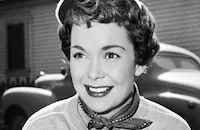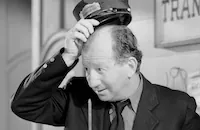The Body Disappears

Brief Synopsis
Cast & Crew
D. Ross Lederman
Jeffrey Lynn
Jane Wyman
Edward Everett Horton
Herbert Anderson
Marguerite Chapman
Film Details
Technical Specs

Synopsis
At a courtroom hearing, "Doc" George Appleby recalls the events that led to the disappearance of Peter DeHaven III: The night of his bachelor party, Peter passes out from drinking. In order to get revenge on practical joker Peter, his friends take his unconscious body and place it on a table in the college dissecting room. Moments later, Professor Shotesbury, who is convinced that he has found the means to bring the dead back to life, finds Peter and steals him with the help of his servant Willie. Shotesbury injects Peter with a serum he has developed, and Peter does indeed awaken, but shortly thereafter, becomes invisible. Appleby's story is continued by Shotesbury's daughter Joan: When Peter wakes up the next day with a terrible hangover, he begs Shotesbury to reverse his invisibility as he is to marry Christine Lunceford. While Shotesbury works on an antidote, Willie drives Peter to Christine's house. There, however, the invisible Peter overhears Christine talking to Robert Struck and learns that Christine loves Robert, but intends to marry Peter for his money. Meanwhile, one of Shotesbury's neighbors has overheard him talking to his invisible monkey, and convinced that Shotesbury is insane, the man assembles the college faculty to determine what to do. At the meeting, Shotesbury admits that he has made a man invisible, and the faculty is now sure that he is mentally unstable. Back at Shotesbury's house, Peter and Joan become better acquainted. Hearing that Robert has been arrested, Peter decides to bail him out, hoping that Robert will marry Christine and he will then be free to marry Joan. When the faculty tell Joan that they have committed her father to a sanitarium, she is worried that Peter will not receive the antidote in time and will be permanently invisible. She injects herself with the serum and she and Peter drive to the sanitarium where Shotesbury also uses the serum. Now that all three are invisible, they leave for home. Shotesbury finishes the story for the judge, explaining that when he and Joan arrived at their home, Peter was not in the car. Then, in the nick of time, Peter arrives in the courtroom, Shotesbury injects him with the antidote and the now visible Peter embraces Joan.

Director

D. Ross Lederman
Cast

Jeffrey Lynn

Jane Wyman

Edward Everett Horton

Herbert Anderson

Marguerite Chapman
David Bruce

Willie Best

Ivan Simpson
Michael Ames
Dewolf Hopper
Natalie Schafer

Charles Halton
Sidney Bracey

Craig Stevens
Wade Boteler

Frank Ferguson
Romaine Callender
Vera Lewis
Paul Stanton

John Hamilton
Stuart Holmes

Charles Drake

Jack Mower
Jimmy Fox
Peggy Diggins

Lorraine Gettman

Hank Mann
Creighton Hale
Wedgwood Nowell
Houseley Stevenson
Harry Lewis
Mary Brodel
George Meader
Georgia Carroll
Tom Stevenson
Eddy Chandler
John Dilson
Frank Sully
Sol Gorss
Leah Baird
Roland Drew

George Meeker
Dick Elliott

Eddie Kane
Thornton Edwards
Ann Edmonds

Juanita Stark
Paula Francis
Crew
Milo Anderson
Hugh Cummings
Scott Darling
Elmer Decker
Edwin B. Dupar
Bryan Foy
Esdras Hartley
Howard Jackson
Stanley Jones
Erna Lazarus
Frederick Richards
Allen G. Siegler
Ben Stoloff
Perc Westmore

Film Details
Technical Specs

Articles
The Body Disappears -
By Glenn Erickson

The Body Disappears -
Quotes
This one's got a lily in his hands. He may be dead, but he's neat about it.- William
They must have embalmed him in Scotch and soda. He's so saturated if a breeze hit him, he'd ripple.- William
Trivia
Notes
The film's working title was The Black Widow. This film marked Natalie Schafer's film debut.















